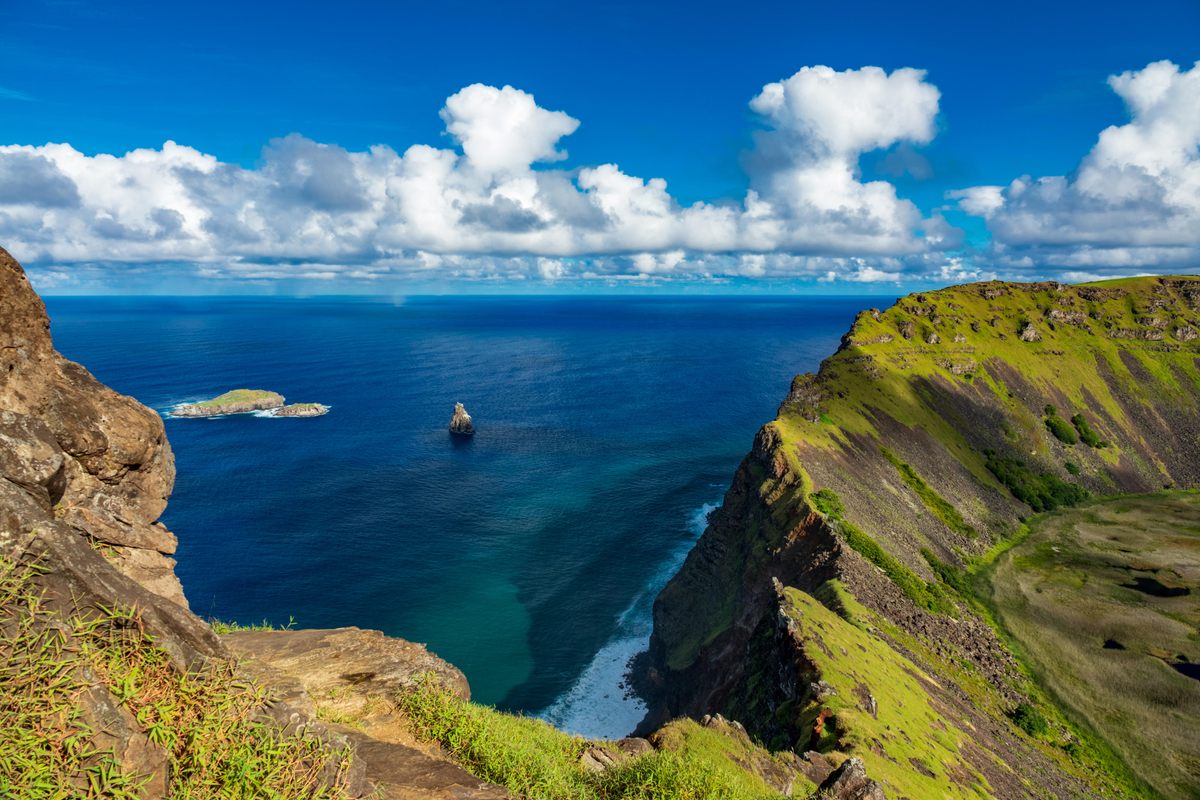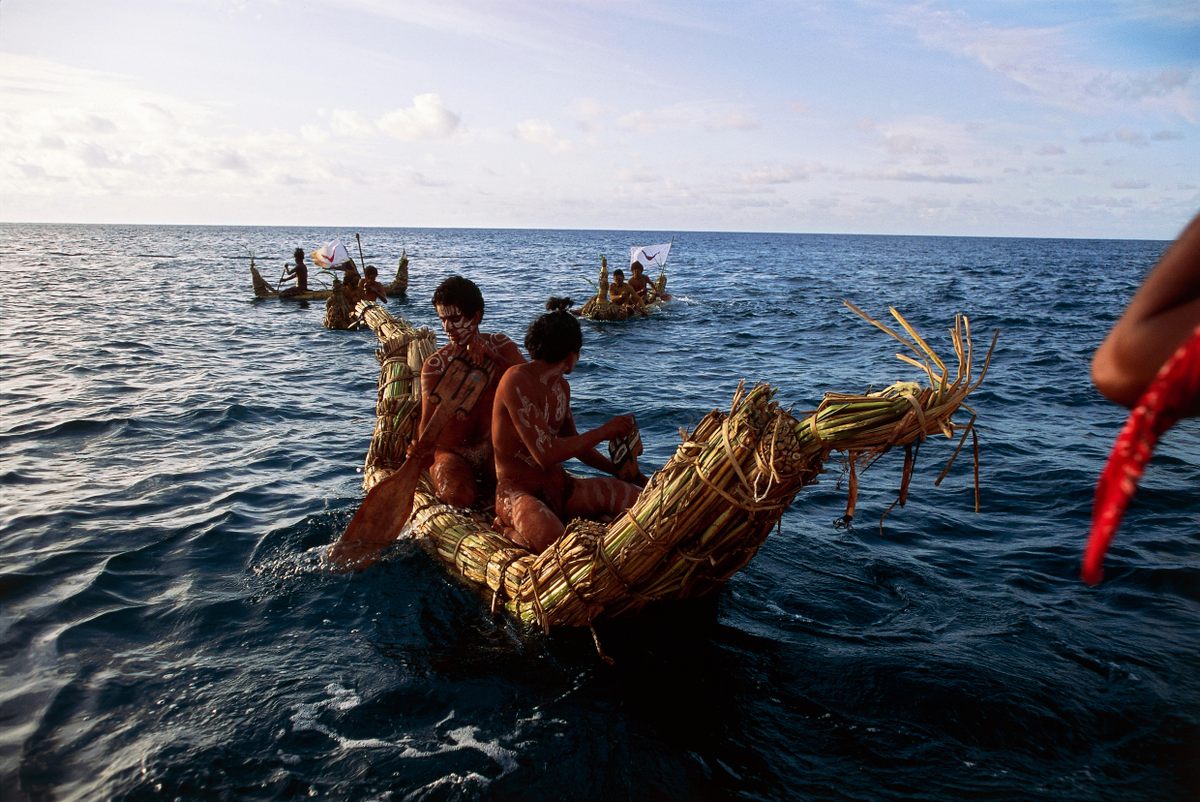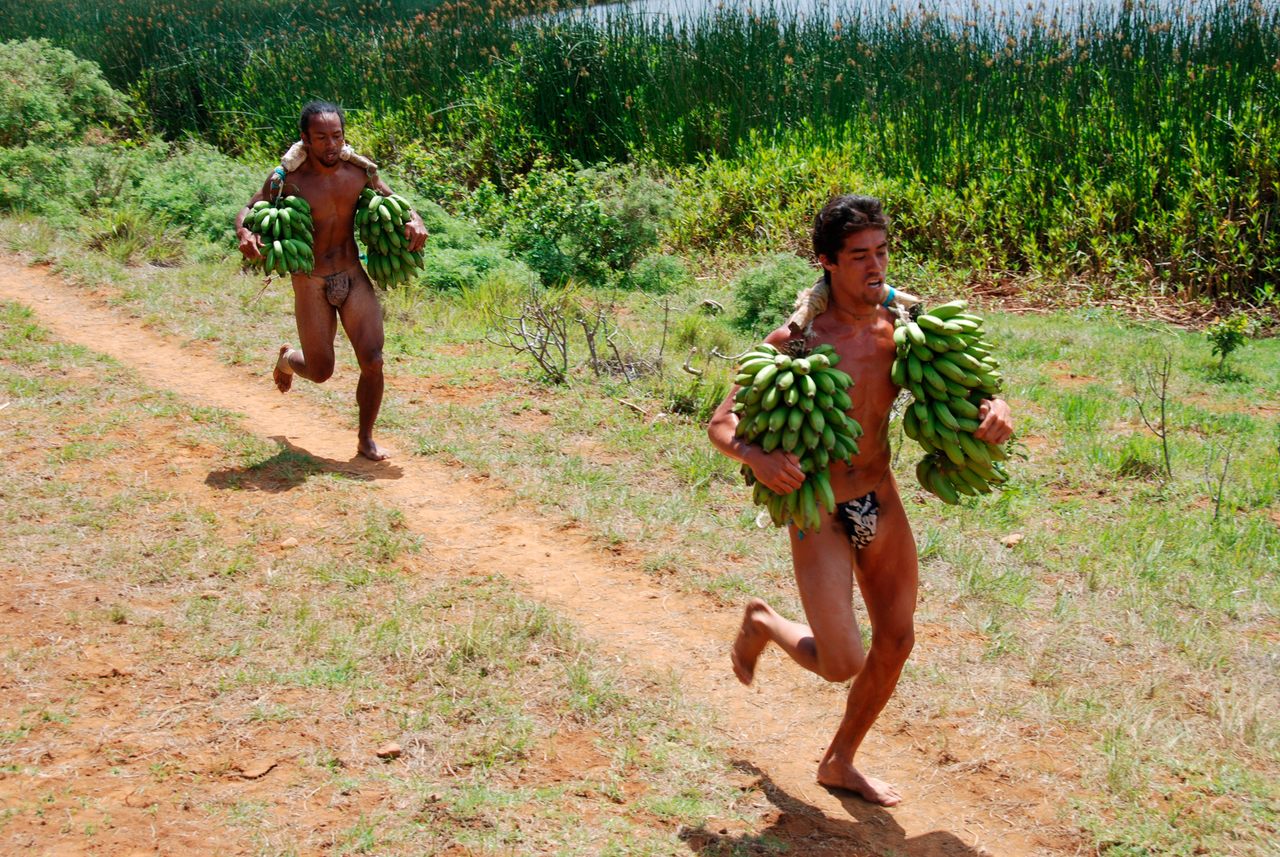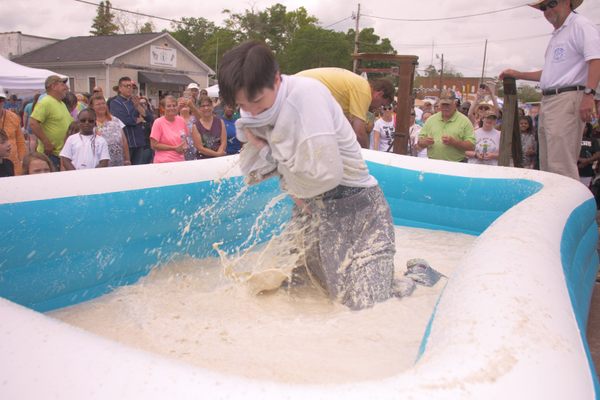The World’s Most Remote Triathlon Involves Bird Eggs, a Volcano, and Bananas
Tau’a Rapa Nui continues to fight for its place against shifting tides.
A clutch of rafts floats on the ocean horizon, just visible from the shore of Rapa Nui. It’s hard to determine from this distance, but they vaguely define the starting point of one of the island’s most anticipated events: an annual triathlon. But this is no ordinary triathlon.
Spectators on shore point with outstretched fingers to the nearing athletes as they furiously raft towards land. Paddling past the numerous sea turtles that glide around the bay, Tumaheke Durán Veri Veri arrives first. He heaves his hand-woven raft onto the sand and runs barefoot up to the island’s main road. He then hoists a 44-pound bundle of bananas over his shoulders and begins to run.
This is the Tau’a Rapa Nui; a demanding sporting event that honors the Rapa Nui’s ancestral tradition. It begins with the rafting, called Vaka Ama; followed by the banana-weighted run, the Aka Venga; and ends with a bodyboard-type paddle race: Natación con Pora. Durán Veri Veri returns to the bay on foot, grabbing a second, smaller raft and launching once more into the ocean. He maintains his lead for the last lap, passing the finishing line comfortably in first place.
Today’s event may seem simple enough, if challenging. But the inspiration for the triathlon traces back to a dangerous competition involving bird eggs and, at one point, a volcanic crater.

“It’s important for the culture, also to show visitors the strength we have on the island,” says Durán Veri Veri, who is a local legend that has won the event “15, 16, 17” times—he’s lost count of his exact number of titles. Now 48, his first participation in the event was in the ‘90s. “You have to be constant: Plan well, eat well, sleep well, and train year-round,” he says.
Following tradition, Durán Veri Veri handmade his two boats; the larger raft is made of 3,000 reeds, while the smaller Pora is around 700 reeds. The sheer challenge of making the rafts is part of the tradition: “It takes a lot (of effort) just to collect the reeds. We go as a community; my family and friends are all behind me working together,” he explains.
The Tau’a Rapa Nui triathlon takes place during the annual celebration of Tapati. Created to preserve the ancestral traditions of the island’s Polynesian people, Tapati dates back to the 1970s. Famous for its enigmatic monolith Moai statues, Rapa Nui (also known as Easter Island) was annexed by Chile in 1888. It sits about 2,300 miles away from the country that governs it and retains a strong, independent identity. To this day, it is one of the most remote inhabited places in the world.

It’s a culture that has endured hardships and struggles: the island’s ancestral practices and traditions were prohibited under Catholic rule, and the Rapa Nui language was banned from being spoken in public. Slave raids and diseases brought by European colonizers led to a drastic population decline—in 1877, the local population dwindled to 111 people.
The island’s surviving clans clandestinely discussed their rights, pushing for greater autonomy and recognition. It was not until the 1990s that Chile implemented the Indigenous Law, making it the state’s duty to respect, protect, and promote Indigenous rights and their lands.
The Rapa Nui Indigenous culture is inherently tied to sport and competition. While European colonizers opted for oppression, war, and slaughter to enforce power, the Rapa Nui clans used tournaments and challenges to determine pre-colonial governance. The Tangata Manu, the “Birdman” cult, was an annual event that determined the governance of the island, which historians estimate date from the early 18th century up to colonization in the 19th century.

“I wanted to revive the Tangata Manu competition,” says Rodrigo Paoa Atamu, the man behind the conception of the first triathlon in the 1990s. “I wanted to simulate what (our ancestors) did.” Paoa Atamu is an author and expert on Rapa Nui’s ancestral sports and traditions. His work was crucial in bringing the Tau’a Rapa Nui, alongside other activities like fishing and banana-tree-trunk throwing, as a central activity in the Tapati festivals.
“Tapati was made to reconstruct our ancestral culture, from food to dance,” says Paoa Atamu. He explains that Tapati was initially characterized by imported elements from continental Chile, “that had nothing to do with our own culture,” including sports like basketball and volleyball. “I had to change all these sports for ancestral ones, to create an appropriate Tapati program,” he says.
Paoa Atamu devised a program directly derived from Rapa Nui tradition “from sports and games that were really from here on the island.” His main inspiration was the famed Tangata Manu, an ancestral competition where elected candidates from different clans would race to retrieve a Sooty Tern egg from a small inlet. According to historian Cristian Moreno Pakarati, these marine birds were considered the “link between the world of the living and the world of spirits,” and were bestowed with a sacred significance by islanders.
Till the mid-1800s, the Tangata Manu competitors scaled down the island’s steep clifftop at the Orongo starting point to reach the shore and swim in the open sea to the inlet. There they’d have to climb the jagged rock face to retrieve the egg and return to Orongo with the egg intact. The winner was granted governance of the island.

It was a perilous competition, with competitors succumbing to shark attacks, treacherous falls, and sheer exhaustion.
Paoa Atamu initially considered the sacred Orongo site for his revived Tau’a Rapa Nui, “but it was dangerous, with loose rocks on the cliff edge.” Instead, he set up the triathlon on the Rano Raraku volcano crater, where competitors would paddle the 1,150 feet of the lake, then run one mile with the bananas, before swimming back across the lake.
Yet in 2018, the Tau’a Rapa Nui faced an unexpected, unbeatable contender: climate change. The lake dried up, forcing the event to move to the open sea; a move welcomed by competitors like Pomare Tepano Dreisger. A nine-time champion of the women’s Tau’a Rapa Nui category, Tepano Dreisger is a former professional surfer who excels in the open water. “My strength is the sea, but my weak point is the running,” she admits.

Tepano Dreisger says that sporting and physical fitness is a way of life for those on the island. “We Polynesians invented surf, which comes from Hawaii. We traveled the world in boats,” she explains. “(The Tau’a Rapa Nui) is a way to maintain these symbols, so the next generation can see the power we have by moving around the world in these small vessels.”
While competitors like Tepano Dreisger and Durán Veri Veri are committed to training and continuing the tradition, the number of participants has dwindled—especially since moving from the crater to the arduous open sea. While dozens used to join the race, this year, only three women and four men participated.
“We need to teach the young to build boats and the authorities to start hosting workshops. I’m here to motivate the next generation,” says Durán Veri Veri, who believes the next generation needs more resources to participate. “They need to rent a truck to get the reeds, find time to make the boat, physically prepare. It’s time and money.”
He proudly wears his wildflower crown, but says his victory has been bittersweet. “I want to keep this alive,” he says. “I don’t want this to disappear.”


















Follow us on Twitter to get the latest on the world's hidden wonders.
Like us on Facebook to get the latest on the world's hidden wonders.
Follow us on Twitter Like us on Facebook